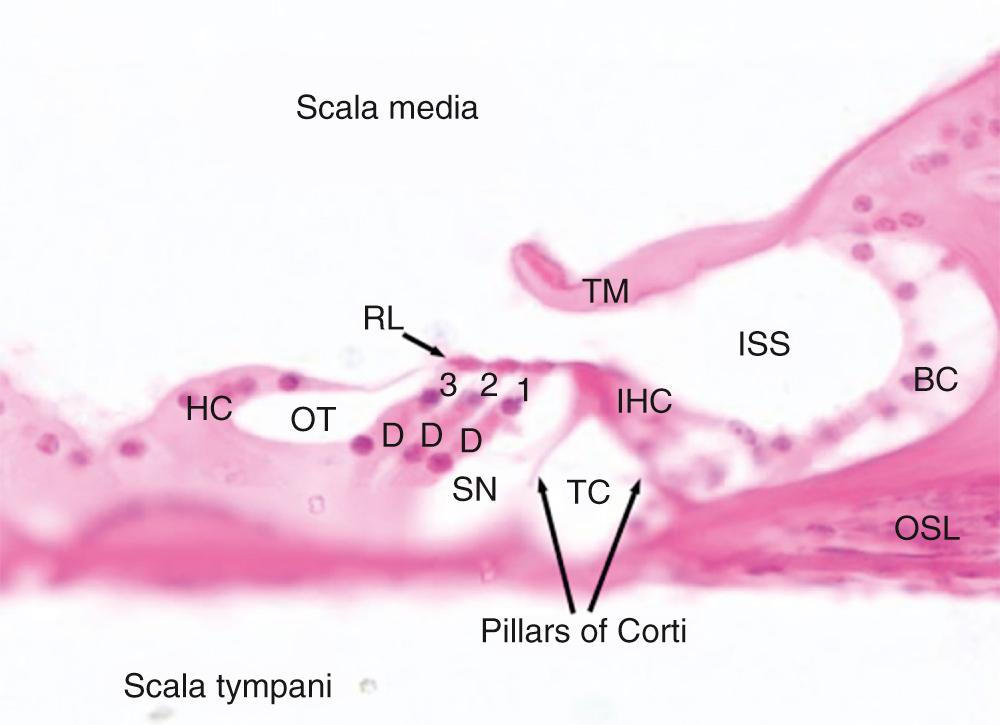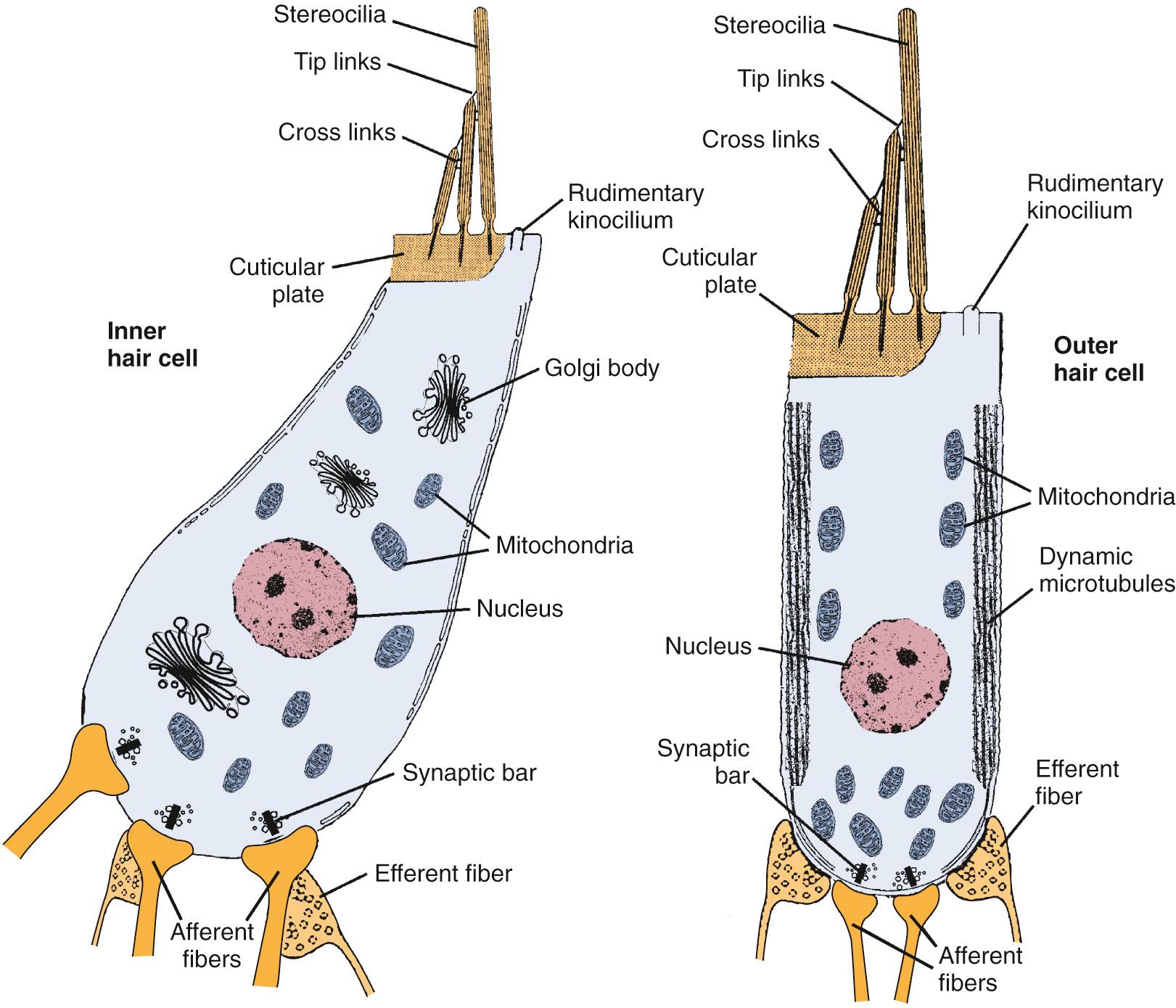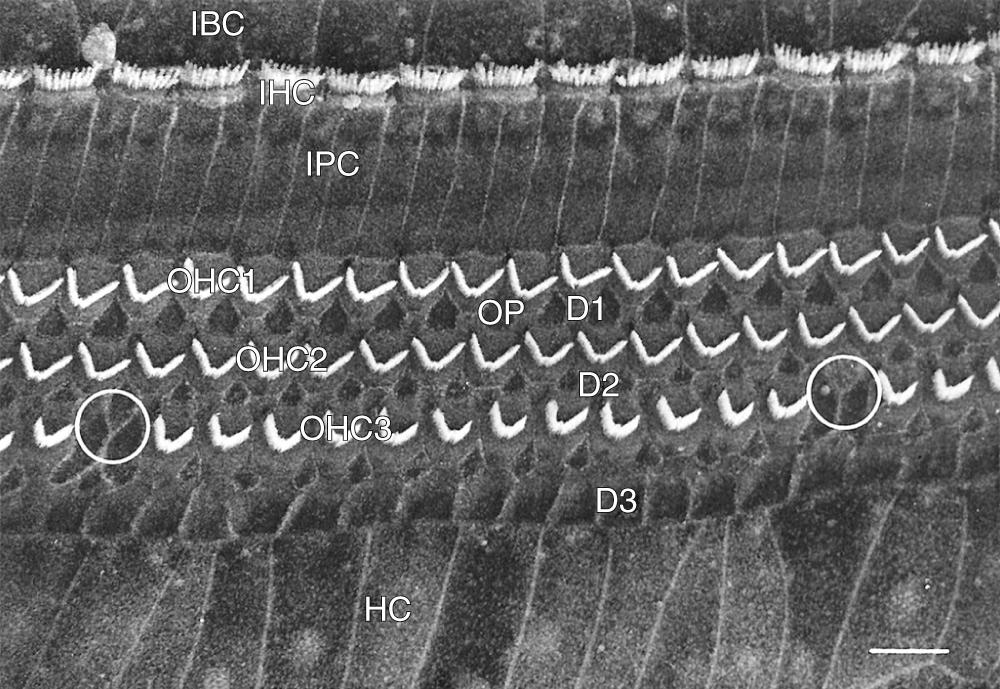Physical Address
304 North Cardinal St.
Dorchester Center, MA 02124
The neuroanatomy of the central and peripheral auditory systems reflects their function: to extract specific information from the complex waveforms of speech, music, and environmental sounds.
The cochlea is organized tonotopically, with low frequencies processed at the apex and high frequencies at the base.
The tonotopic organization starting in the cochlea is reiterated throughout the central auditory system.
The organ of Corti is the principal sensory structure in the cochlea and contains the inner and outer hair cells.
Afferent auditory neurons have their cell bodies in the spiral ganglion, with bipolar axons connecting the hair cells to the central auditory system.
The cochlear nucleus is the only entry point to the central nervous system for all peripheral auditory information.
Within the central auditory system, parallel ascending pathways independently extract temporal, spectral, and intensity cues from sound stimuli.
The superior olivary complex and inferior colliculus are important in sound localization.
The inferior colliculus is the gateway for almost all ascending and descending pathways between the telencephalon and the lower centers.
The medial geniculate body and auditory cortex integrate auditory information with multiple other sensory modalities.
Efferent auditory neurons arise from the superior olivary complex and innervate outer hair cells of the ipsilateral and contralateral cochleae.
This chapter provides a basic overview of the neuroanatomy of the auditory system from the cochlea to the cortex. Auditory processing involves the encoding of sound energy into electrical signals. This process begins at the periphery at the cochlea and progresses through the cochlear nerve, brain stem, and midbrain, undergoing final integration within the cortex. Knowledge of the neuroanatomy of these regions is important for understanding most forms of congenital and hereditary deafness, auditory processing disorders, and the indications for and functions of auditory prostheses. These neuroanatomic regions may also play crucial roles in age-related difficulties with word recognition, hearing under noisy conditions, and the generation and perception of tinnitus.
The inner ear, within the petrous portion of the temporal bone, is encased in a bony structure called the osseous labyrinth or bony labyrinth. The bone that forms the cochlea and vestibular labyrinth is the hardest bone in the human body and is akin to ivory in its density. The labyrinth consists of the three following contiguous sections:
The cochlea
The vestibule
The semicircular canals
The initial point for the communication of sound energy between the middle and inner ears occurs at the oval window of the vestibule, where the stapes footplate abuts the oval window membrane. The cochlea is a snail-shaped structure that has a wide diameter at the base and narrows over  turns until it reaches its apex. Fig. 127.1 shows a cross section of the cochlea through the basal, middle, and apical turns.
turns until it reaches its apex. Fig. 127.1 shows a cross section of the cochlea through the basal, middle, and apical turns.

The central core of the cochlea is the modiolus, a highly porous bone that allows the passage of auditory nerve fibers from the internal auditory meatus to the hair cell synapses. Extending from the modiolus is the osseous spiral lamina , which coils around the center of the cochlea and provides partial division of the upper and lower cochlear chambers into the scala vestibuli and scala tympani, respectively. At the apex of the cochlea is the helicotrema, where these fluid-filled scalae are in communication. The spiral lamina is also the point of attachment for the basilar membrane, which is the lower border of the scala media.
Along the length of the cochlea, the widths of the spiral lamina and basilar membrane are inversely related. Specifically, they appear as follows:
Osseous spiral lamina
Wider at the base and narrower toward the apex
Basilar membrane
Narrower at the base and wider at the apex
Thicker at the base and thinner at the apex
This anatomy is a key factor that confers frequency specificity to the basilar membrane. Namely, the cochlea is responsive to high frequencies at the base and low frequencies at the apex.
The membranous labyrinth of the cochlea follows the shape of the osseous cochlea and encloses a third cochlear chamber, the scala media. It is distinct from the scala vestibuli and scala tympani, which—as already mentioned—are connected at the helicotrema. The scala media is bordered
Superiorly by the Reissner membrane
Inferiorly by the basilar membrane
Laterally by a portion of the outer cochlear wall
This sets up a two-fluid system within the cochlea, which creates an environment crucial to
The mechanical displacement of the basilar membrane from the traveling wave
The cellular depolarization and subsequent synaptic activity in the hair cells
Key aspects of the two-fluid system are as follows:
Endolymph
Scala media
High potassium; low sodium
Akin to intracellular fluid
Maintained by the stria vascularis
Communicates with the endolymphatic duct and sac
Disorders include endolymphatic hydrops (Ménière disease) or wide vestibular aqueduct
Perilymph
Found in scala vestibuli, scala tympani, and internal spaces of the organ of Corti
Low potassium; high sodium
Akin to extracellular fluid
Communicates with cerebrospinal fluid via cochlear aqueduct
Likely conduit for bacterial meningitis into the inner ear
The organ of Corti is situated on the basilar membrane ( Fig. 127.2 ). It runs longitudinally along the length of the basilar membrane and comprises multiple types of epithelial cells and structures. Medially, seated atop the osseous spiral lamina, is the spiral limbus, a thickened band of periosteum that serves as the point of medial attachment for the Reissner membrane and gives rise to the tectorial membrane, which lies over the inner and outer hair cells. The tectorial membrane is a compliant gelatinous structure composed primarily of collagen II fibers; it serves as a mass load that moves similarly to a rubber band. Lateral to the spiral limbus is the inner spiral sulcus, which is lined with the border cells of Held. In addition, one row of inner hair cells is present, the cell bodies of which are surrounded by supporting cells called phalangeal cells.

Although the scala media is filled with endolymph, the spaces within the organ of Corti are filled with perilymph. The perilymph-filled spaces and their boundaries within the organ of Corti are shown in Fig. 127.2 and include
The tunnel of Corti
Between the inner and outer pillar cells
Space of Nuel
Between the outer pillar cells and first outer hair cells
Outer tunnel
Between the third outer hair cells and Hensen cells
Intercellular spaces
Surrounding hair cells themselves
The phalangeal cells, phalangeal processes of the Deiters cells, and superior surfaces of the hair cells form the reticular lamina, a tightly interwoven matrix that supports the apices of the hair cells. The reticular lamina forms a barrier from endolymph, the fluid in the scala media, which, owing to its ionic composition, is toxic to hair cells.
The inner and outer hair cells function as receptor cells that transduce mechanical energy into an electrochemical signal to stimulate the auditory nerve. Fig. 127.3 presents schematic examples of inner and outer hair cells. The apical portion of all hair cells includes a thickened region called the cuticular plate, which, in conjunction with the supporting cells, forms the reticular lamina. Rooted in the cuticular plate of each hair cell and projecting through the reticular lamina (into endolymph) are bundles of actin filaments known as stereocilia, stiff hair-like structures that deflect with mechanical disturbances. Adjacent to this is a noncuticular region that contains a rudimentary kinocilium. Cellular distinction between the hair cells include
Inner hair cells
Flask shaped: wide at bottom, narrow at the top
High concentration of metabolic organelles
Golgi bodies, mitochondria
Passive transducers of mechanical (acoustic) motion to electrical activity
Many afferent fibers contact the base
Indirect contact by efferent fibers
Outer hair cells
Cylindrical: narrow at bottom and top
High concentration of motile structures
Microfilaments and microtubules
Active participants in tuning the cochlea to specific frequencies
Fewer afferent fibers contact the base
Direct contact by efferent fibers

The inner and outer hair cells are differently arranged within the organ of Corti but have some similarities ( Fig. 127.4 ). Key points include the following:
Inner hair cells
Approximately 3500
Arranged in one row
Modiolar side of tunnel of Corti
Stereocilia are shallow and U shaped
Open toward the modiolus
Two or more rows of stereocilia per cell
Stereocilia have graduated lengths
Longest on the strial side and shortest on the modiolar side
Outer hair cells
Approximately 12,000
Arranged in three rows
Strial side of the organ of Corti
Stereocilia are V or W shaped
Open toward the modiolus
Three or more rows of stereocilia per cell
Stereocilia have graduated lengths
Longest on the strial side and shortest on the modiolar side

The longest stereocilia on the outer hair cells contact the tectorial membrane, which results in deflection of the stereocilia with basilar membrane movement. The stereocilia are connected to each other by filamentous links laterally, by cross links, and from the tips of shorter stereocilia to the sides of the taller ones by tip links. These multiple links ensure that the connected stereocilia move as a unit when the longer stereocilia are deflected.
Become a Clinical Tree membership for Full access and enjoy Unlimited articles
If you are a member. Log in here